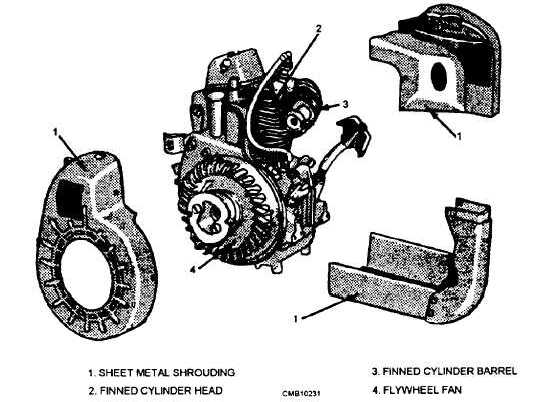In air-cooled engines the cylinders are mounted independently to the crankcase so an adequate volume of air can circulate directly around each cylinder, absorbing heat and maintaining cylinder head temperatures within allowable limits for satisfactory operation (fig. 6-2). In all cases, the cooling action is based on the simple principle that the surrounding air is cooler than the engine. The main components of an air- cooled system are the fan, shroud, baffles, and fins. A typical air-cooled engine is shown in figure 6-3.
Fan and Shroud
All stationary air-cooled engines must have a fan or blowers of some type to circulate a large volume of cooling air over and around the cylinders. The fan for the air-cooled engine shown in figure 6-3 is built into the flywheel. Notice that the shrouding, or cowling, when assembled will form a compartment around the engine so the cooling air is properly directed for effective cooling. Air-cooled engines, such as those used on motorcycles and outboard engines, do not require the use of fans or shrouds because their movement through the air results in sufficient airflow over the engine for adequate cooling.
Baffles and Fins
In addition to the fan and shroud, some engines use baffles or deflectors to direct the cooling air from the fan to those parts of the engine not in the direct path of the airflow. Baffles are usually made of light metal and are semicircular, with one edge in the air stream, to direct the air to the back of the cylinders.
Most air-cooled engines use thin fins that are raised projections on the cylinder barrel and head (fig. 6-3). The fins provide more cooling area or surface and aid in directing airflow. Heat, resulting from combustion, passes by conduction from the cylinder walls and cylinder head to the fins and is carried away by the passing air.
Maintaining the Air-cooled System
You may think that because the air-cooled system is so simple it requires no maintenance. Many mechanics think this way and many air-cooled engine failures occur as a result. Maintenance of an air-cooled system consists primarily of keeping cooling components clean. Clean components permit rapid transfer of heat and ensure that nothing prevents the continuous flow and circulation of air. To accomplish this, keep fans, shrouds, baffles, and fins free of dirt, bugs, grease, and other foreign matter. The engine may look clean from the outside, but what is under the shroud? An accumulation of dirt and debris here can cause real problems; therefore, keep this area between the engine and shroud clean.
Paint can cause a problem. Sometimes a mechanic will reduce the efficiency of the cooling system by the

Figure 6-3. - Air-cooled engine.
Continue Reading